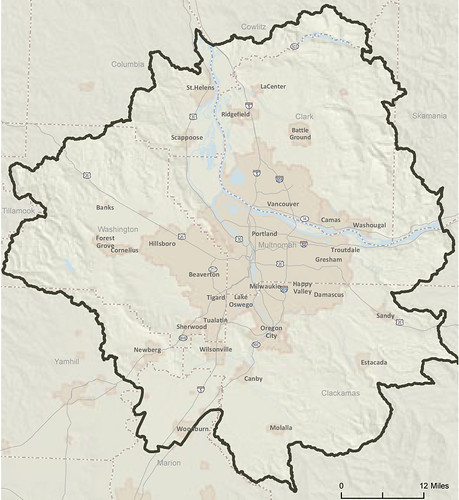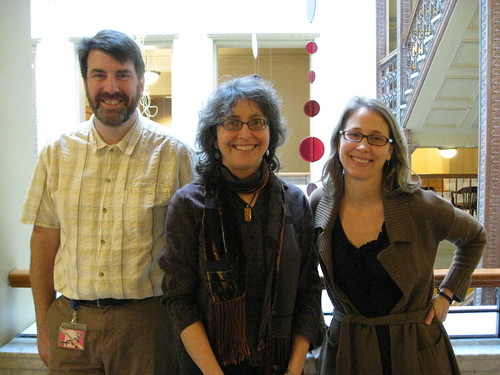Tag: policy
What if our cities had no trees?
Why plant trees in cities? This video shows the many ways our trees can help us.
You may recognize three people in this video who have helped our Portland-Vancouver area treescape, including a Friends of Trees staff member. Many thanks to Portland Bureau of Environmental Services, Portland Parks & Recreation, and all of you who have helped make our city forests grow.
And thank you, American Forests, for all you do for urban forests across our country.
The Intertwine & a regional urban forestry strategy
“Intertwine” means “to twist or twine together, to be mutually involved.”
There’s probably no better word to describe the coalition of environmentally diverse partners and the nearly 3,000 square miles of varied green corridors in the Portland-Vancouver area that the coalition works together to sustain. The goal is to advocate as a team at the federal, state and regional levels to create a healthy Intertwine, and to make The Intertwine accessible to a wide range of people.
Officially founded in 2011, The Intertwine already has 70 member organizations, or partners, including Friends of Trees. It traces its roots from John Charles Olmsted’s vision of a network of interconnected boulevards and green spaces between the Willamette and Columbia rivers to the establishment of the Columbia Regional Association of Governments (CRAG) in the early 1970s and the founding of Metro Regional Government afterward, whose master plan calls for “a cooperative regional system of natural areas, open space, trails, and greenways for wildlife and people.”

The October 25, 2012 Intertwine Summit began with a discussion of The Intertwine’s Regional Conservation Strategy for the Greater Portland-Vancouver Region and a companion document, the Regional Conservation Strategy and Biodiversity Guide. According to its executive summary, the Regional Conservation Strategy presents “a broad regional view of conservation while highlighting ongoing efforts and potential actions at the local level. It is a starting point for future collaboration, not a substitute for existing planning.”Read More
What did the tree planter say to the White House?
Dr. Jackie Cole watched half her city’s trees—some 100 years old—die as Galveston became a “city of dead trees” after a drought weakened 40,000 of them, and a hurricane flooded them afterward with saltwater.
Dr. Cole’s leadership in helping remove the dead trees and plant new ones gave her insight into the value that government agencies assign to city trees. FEMA funds were used to remove the trees, but no funds were available to replace them.
Honored as a “Champion of Change” at the White House last month, Dr. Cole made three key points:
- Trees must be shifted over from being thought of as beautification and landscaping to being thought of as critical infrastructure.
- Trees clean our air, filter our water, help with stormwater runoff, lower asthma rates, lower energy use, increase property values, and lower crime levels.
- We cannot live without trees.
Forward to 2:30 in this video to hear Dr. Cole herself.
Understanding the Citywide Tree Project
By Erica Timm

Less than a month ago, on Wednesday, April 13, 2011, Portland City Council unanimously adopted the Citywide Tree Policy Review and Regulatory Improvement Project (Tree Project). As Mayor Sam Adams proclaimed, “The Tree Project has been a journey. Thanks to our community’s tenacity, the Bureau of Planning and Sustainability’s leadership and critical assistance from other city bureaus, dozens of disparate viewpoints have been woven into a cohesive framework for the future of our trees.”
Inspired by the collaborative process and support from city leaders and the community, Friends of Trees sat down with Roberta Jortner and Morgan Tracy to learn more about the process, benefits, and changes we’ll see in the future as the policy is implemented. Jortner and Tracy, two of the lead city staff members on the Tree Project team at the Bureau of Planning and Sustainability, highlighted several key impacts of the new code.
Showcasing the Urban Forest and Improving Customer Service
A major benefit of the Tree Project is that it consolidates most city tree rules into one title, treating trees as a citywide asset. The consolidation creates a new title within city code just for trees, really showcasing the urban forest and elevating Portland’s Urban Forest Program. The provisions of Title 11, “Trees,” combined with updates to Portland’s zoning code, strengthen the city’s tools for managing the urban forest asset while providing flexibility for property owners and developers.
The Tree Project aims to sustain the quality of the forest by encouraging the retention of healthy trees and reducing overall loss by ensuring trees are replaced when they are removed. New standards will improve preservation of existing trees and tree planting on development sites, without significant impacts on permitting cost or time.
The new code is designed to enhance the transparency and consistency of the city’s decisions, making them easier to understand and more equitable. Public and private trees are both addressed through standardized systems for development and non-development situations. Additional customer service improvements include the creation of a single point of contact and a tree manual describing the benefits of trees, tree care, and tree-related rules. The Tree Project also calls for piloting a 24-hour hotline for tree-related questions and concerns.
Recognizing the Urban Forest is Dynamic & Changing
While it is always important to think ahead and plant the right tree in the right place, the code recognizes that the urban forest is dynamic and contains provisions allowing tree removal with replacement. This enables neighbors to change landscape designs that include trees, and provides flexibility for potential property enhancements that may be impacted by trees, such as solar access.
An improvement to the city’s existing, notoriously confusing tree permit system is a new streamlined and standardized permit system that will apply to all street trees with a trunk of three inches or larger in diameter and all private trees with trunks 12 inches or larger in diameter. Permits are required to remove private trees with trunks six inches or larger in diameter in some overlay zones and plan districts, so it is always good to check with the city prior to removing a tree. (Note: trunk diameter is measured at the 4.5-foot mark on the tree.)
A simple “tree-for-tree” replacement is required for most tree removals, including removing a single private yard tree. A person removing a large, healthy tree, or multiple trees, may be required to replace the tree “inch-for-inch” by planting multiple trees that equal the total trunk diameter of tree loss. If sufficient space is not available on the site to replace the tree(s) removed, the city forester may waive replacement or require payment into the city’s tree fund, which will be spent to plant trees within the same watershed as those removed.
Outreach, Implementation & Getting Involved
Some changes will take effect on July 1, 2011, but the majority of the changes, including the code consolidation into the new tree code (Title 11), the updated development standards, tree permit system, and some of the customer service enhancements, will take effect on February 1, 2013.
The city is now preparing to implement the programs established through the Tree Project and will be developing strategies to continue public outreach. Community support will be critical to help ensure that trees are protected, planted, maintained, and replenished through programs established through the Tree Project and other city and community programs. More information, including a project summary, can be found at the project website: http://www.portlandonline.com/bps/treeproject
– Timm is a Neighborhood Trees Specialist with Friends of Trees
Portland City Council approves policies proposed by Citywide Tree Project
From Portland’s Bureau of Planning & Sustainability
On Wednesday, April 13, Portland City Council voted unanimously to approve amendments to the December 2010 draft of the Citywide Tree Policy and Regulatory Improvement Project. The amendments were made in response to input from individuals and community organizations.
The Council referred to the comprehensive overhaul of the city’s tree rules as “landmark legislation” and expressed appreciation for the many Portlanders, organizations, and city bureaus that have participated in this multi-year effort.
The Citywide Tree Project will be implemented in phases, starting with the development of informational materials and a tree manual, permit tracking system upgrades, and initial amendments to the Portland Zoning Code in July 2011. Implementation of the new consolidated code, Title 11 (Trees), a second set of zoning code amendments, a new single point of contact, and a 24-hour tree hotline pilot project will begin in February 2013.
A project summary, adopted ordinances, amendments to the Citywide Tree Project Recommended Draft to City Council (December 2010), and a list of code amendments that will become effective this July are posted along with general information about the project at www.portlandonline.com/bps/treeproject.
Friends of Trees has been involved in the Citywide Tree Project for many years and is pleased that City Council approved the policy changes. Watch this blog later this week for more information about the new policies. You can also read more about community support for tree policy changes in this March story on our blog.
